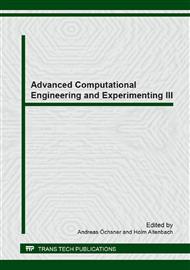p.1
p.5
p.11
p.15
p.21
p.31
p.37
p.43
Influence of Spur Gears Hardened Method to Allowable Stress Numbers for Bending
Abstract:
The presented paper deals with comparison of spur gears classical and modern hardening process of the bending fatigue properties. It concerned particularly the hardened surface of the tooth flank using optical source of electromagnetic radiation. The results of fatigue tests were obtained on a servo-hydraulic testing machine LFV 100 kN made by walter+bai ag. These tests were defined by the standard ISO 6336 as method B, when testing is carried out under reference conditions close to the real operation. Comparison of test samples is also carried out on the basic of the achieved local hardness and hardened layer thickness in the tooth root, which is an initiation of fatigue crack.
Info:
Periodical:
Pages:
11-14
Citation:
Online since:
April 2014
Authors:
Price:
Сopyright:
© 2014 Trans Tech Publications Ltd. All Rights Reserved
Share:
Citation:


